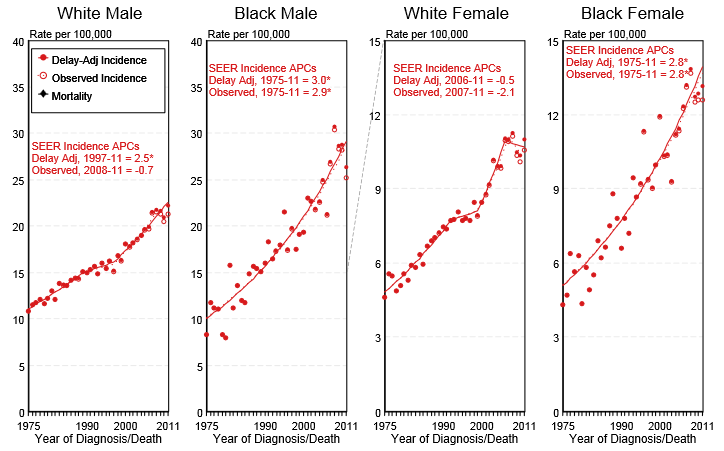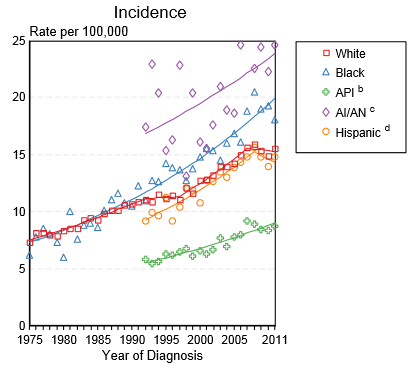Renal cell carcinoma epidemiology and demographics
Editor-In-Chief: C. Michael Gibson, M.S., M.D. [1]; Associate Editor(s)-in-Chief: Yazan Daaboul; Serge Korjian; Rim Halaby, M.D. [2]
|
Renal cell carcinoma Microchapters |
|
Diagnosis |
|---|
|
Treatment |
|
Case Studies |
|
Renal cell carcinoma epidemiology and demographics On the Web |
|
American Roentgen Ray Society Images of Renal cell carcinoma epidemiology and demographics |
|
Renal cell carcinoma epidemiology and demographics in the news |
|
Risk calculators and risk factors for Renal cell carcinoma epidemiology and demographics |
Overview
Renal cell carcinoma is considered the 7th most common cancer in men and 9th most common cancer in women, accounting for approximately 2-3% of malignant tumors in adults. Men are twice more likely to be affected than women with a mean age of presentation at 60 years. Most renal cell carcinomas develop sporadically, while only a small number of cases are of genetic diseases. Clear cell carcinomas are the most common renal cell carcinomas and collecting-duct carcinomas are the least common. Renal cell carcinomas are mostly found incidentally during radiological abdominal work-up.
Epidemiology
Prevalence
- Renal cell carcinoma accounts for approximately 2-3% of all malignant tumors in the adult population.[1] Most cases of renal cell carcinoma are sporadic; whereas only approximately 2-3% of all cases are familial, most of which have an autosomal-dominant pattern of inheritance.[1]
- In the United States, the age-adjusted prevalence of kidney cancer is 85.9 per 100,000 in 2011.[2]
Incidence
- The delay-adjusted incidence of kidney cancer in 2011 was estimated to be 15.88 per 100,000 persons in the United States.[2]
- In 2011, the age-adjusted incidence of kidney cancer was 15.28 per 100,000 persons in the United States.[2]
Age
- The median age of presentation is typically 60 years.[1]
- While the overall age-adjusted incidence of kidney cancer in the United States between 2007 and 2011 is 15.5 per 100,000, the age-adjusted incidence of kidney cancer by age category is:[2]
- Under 65 years: 8.3 per 100,000
- 65 and over: 65 per 100,000
Gender
- Renal cell carcinomas is considered the 7th most common cancer in men and the 9th most common cancer in women.
- The male to female ratio is approximately 2 to 1.[1] The ratio increases dramatically increases in sporadic cases of papillary renal cell carcinomas, reaching a 5 to 1 ratio.[3]
- In the United States, the age-adjusted prevalence of kidney cancer by gender in 2011 is:[2]
- In males: 113.2 per 100,000
- In females: 63.3 per 100,000
- In the United States, the delay-adjusted incidence of kidney cancer by gender in 2011 is:[2]
- In males: 21.84 per 100,000 persons
- In females: 10.81 per 100,000 persons
- In the United States, the age-adjusted incidence of kidney cancer by gender on 2011 is:[2]
- In males: 21.02 per 100,000 persons
- In females: 10.4 per 100,000 persons
- Shown below is an image depicting the delay-adjusted incidence and observed incidence of kidney cancer by gender and race in the United States between 1975 and 2011. These graphs are adapted from SEER: The Surveillance, Epidemiology, and End Results Program of the National Cancer Institute.[2]
Race
- Shown below is a table depicting the age-adjusted prevalence of kidney cancer by race in 2011 in the United States.[2]
| All Races | White | Black | Asian/Pacific Islander | Hispanic | |
| Age-adjusted prevalence | 85.9 per 100,000 | 90.8 per 100,000 | 91.3 per 100,000 | 46.7 per 100,000 | 86.7 per 100,000 |
- Shown below is an image depicting the incidence of kidney cancer by race in the United States between 1975 and 2011.[2]
API: Asian/Pacific Islander; AI/AN: American Indian/ Alaska Native
Percent Distribution of Renal cell Carcinoma by Histology
More than 70% of renal cell carcinomas are clear cell carcinomas. Papillary carcinomas are the second most common renal cell carcinomas. The least common types of renal cell carcinomas are collecting-duct renal cell carcinomas, accounting for less than 1% of all cases.[3]
References
- ↑ 1.0 1.1 1.2 1.3 Rini BI, Campbell SC, Escudier B (2009). "Renal cell carcinoma". Lancet. 373 (9669): 1119–32. doi:10.1016/S0140-6736(09)60229-4. PMID 19269025.
- ↑ 2.0 2.1 2.2 2.3 2.4 2.5 2.6 2.7 2.8 2.9 Howlader N, Noone AM, Krapcho M, Garshell J, Miller D, Altekruse SF, Kosary CL, Yu M, Ruhl J, Tatalovich Z,Mariotto A, Lewis DR, Chen HS, Feuer EJ, Cronin KA (eds). SEER Cancer Statistics Review, 1975-2011, National Cancer Institute. Bethesda, MD, http://seer.cancer.gov/csr/1975_2011/, based on November 2013 SEER data submission, posted to the SEER web site, April 2014.
- ↑ 3.0 3.1 Cohen HT, McGovern FJ (2005). "Renal-cell carcinoma". N Engl J Med. 353 (23): 2477–90. doi:10.1056/NEJMra043172. PMID 16339096.

